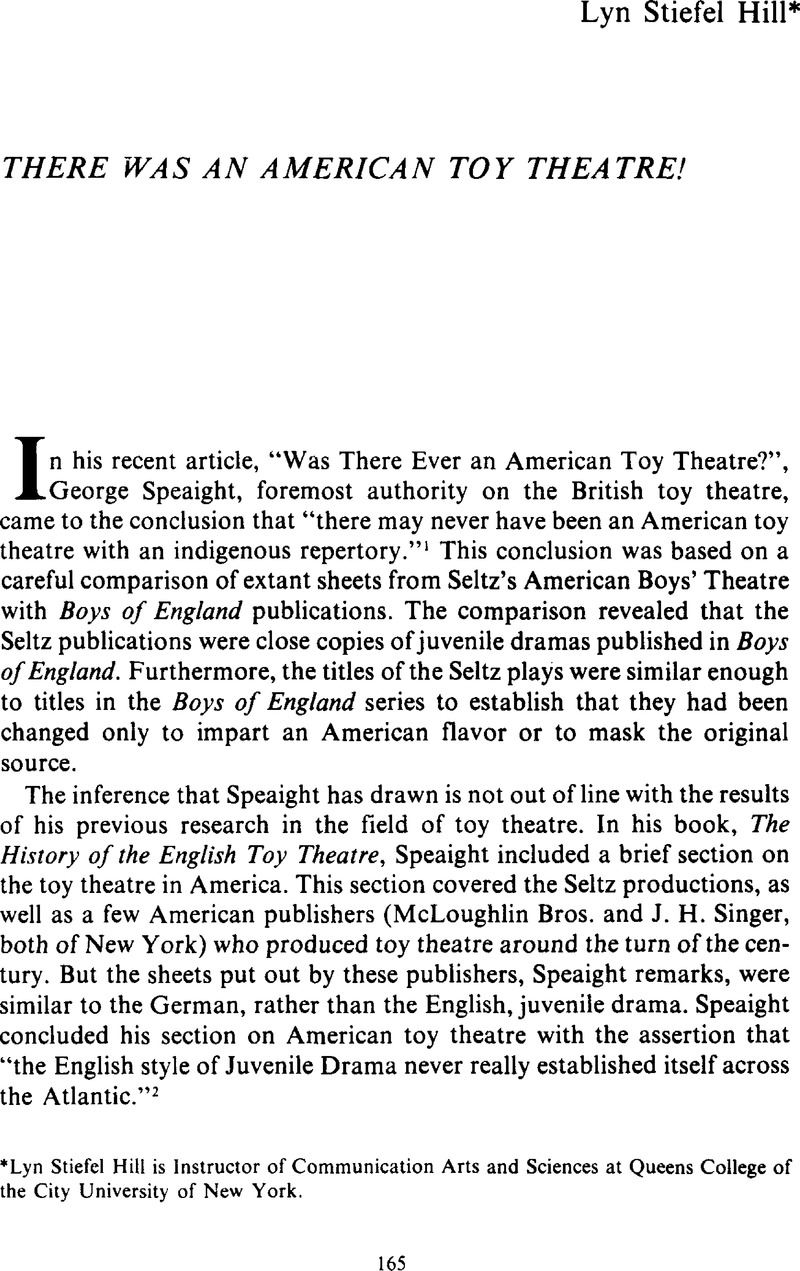No CrossRef data available.
Article contents
There was an American Toy Theatre!
Published online by Cambridge University Press: 07 July 2009
Abstract

- Type
- Notes and Comments
- Information
- Copyright
- Copyright © American Society for Theatre Research 1975
References
1 Speaight, George, “Was There Ever an American Toy Theatre?,” Nineteenth Century Theatre Research, I (1973), 93.Google Scholar
2 Speaight, George, The History of the English Toy Theatre, rev. ed. (Boston, 1969), p. 143.Google Scholar
3 “Brownies on Stage,” Boston, Globe, 8 December 1895.Google Scholar
4 In fact, the Globe, in the winter and spring of 1896 after the toy theatre series had ended, did publish a number of conventional tableaux cut-outs, some of which were intended to be set up on the same toy theatre stages published earlier. Some of these had seasonal themes (e.g., “The Skaters,” 5 January 1896); some had patriotic themes (e.g., “The White House,” 1 March 1896, “Battle of New Orleans,” 29 March 1896); and some had dramatic themes (e.g., “The Chariot Race,” 24 May 1896, “Minstrel Show,” 17 May 1896 and “Circus,” 10 May 1896). However, even those tableaux with dramatic themes differed from the Globe theatre cut-outs in that they supplied only one setting and no plot outline.
5 “Brownies on Stage,” loc. cit.
6 Speaight, History of the English Toy Theatre, p. 14.
7 Atkinson, Brooks, Broadway (New York, 1970), p. 3.Google Scholar
8 Henniger, Alice Minnie Hertz, “The Drama's Value for Children,” Good Housekeeping (November 1913), 636.Google Scholar
9 Wood, James Playsted, Magazines in the United States, 3rd ed. (New York, 1971), p. 125.Google Scholar
10 Koch, Fritz, Paper Toys and How To Make Them (Philadelphia, 1907), p. 9.Google Scholar
11 “A Suggestion for Christmas,” Pictorial Review (December 1913), 28Google Scholar. In connection with the theory that cut-outs provide a valuable educational tool for training children, two facts are notable. First, although the original British toy theatre publishers never seem to have used this claim to advertise their merchandise, a recent (January 1972) price list for Pollock's Toy Theatres states: “Pollock's miniature theatres and the plays associated with them provide admirable basis for educational activities by children, whether in the home or at school. The organization of a production involves cutting out and painting scenes and characters, manipulating them on the stage, learning parts and speaking them ‘off stage,’ operating simple lighting, sound and music effects: there is thus scope for all to find occupations appropriate to their abilities.” Second, today, most progressive American educators believe that professionally prepared cut-outs inhibit rather than expand a child's creativity and artistic potential.
12 The Pictorial Review advertisement quoted later on in this paper contains the ambiguous: “Of course you can use any theatre as a makeshift, but who wants a makeshift when you can get a real theatre made on purpose for this play …” This might imply that the child could use a homemade “makeshift” theatre, or it might mean that there were other theatres available which would seem “makeshift” if used for the Pictorial Review plays. If the latter interpretation is correct, then there were at least some other toy theatres on the market. However, these may well have been imports.
13 “Ask your Mother or Father to Get this Theatre for You,” Pictorial Review (October 1913), 23Google Scholar.
14 I have searched the pages of the following: Delineator, 1915–1923Google Scholar; Good Housekeeping, 1913–1925Google Scholar; Ladies Home Journal, 1913–1925Google Scholar; McCall's, 1913–1923Google Scholar; Pictorial Review, 1913–1925Google Scholar; Woman's Home Companion, 1913–1923Google Scholar.
15 “Peter Newell's Movies: A Visit to Santa Claus's Workshop,” Delineator (January 1915), 16Google Scholar.
16 The author wishes to express her thanks to Louise Kaufman of Cherry Vale, Kansas, a private collector of toy theatres, who provided an initial set of references and to Professor A.H. Saxon of the Graduate School, City University of New York, for his help and encouragement in the preparation of this article.




